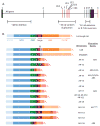Biologic and clinical significance of androgen receptor variants in castration resistant prostate cancer
- PMID: 24859991
- PMCID: PMC4277180
- DOI: 10.1530/ERC-13-0470
Biologic and clinical significance of androgen receptor variants in castration resistant prostate cancer
Abstract
As prostate cancer (PCa) progresses to the lethal castration resistant and metastatic form, genetic and epigenetic adaptation, clonal selection, and evolution of the tumor microenvironment contribute to the emergence of unique biological characteristics under the selective pressure of external stresses. These stresses include the therapies applied in the clinic or laboratory and the exposures of cancers to hormonal, paracrine, or autocrine stimuli in the context of the tumor micro- and macro-environment. The androgen receptor (AR) is a key gene involved in PCa etiology and oncogenesis, including disease development, progression, response to initial hormonal therapies, and subsequent resistance to hormonal therapies. Alterations in the AR signaling pathway have been observed in certain selection contexts and contribute to the resistance to agents that target hormonal regulation of the AR, including standard androgen deprivation therapy, antiandrogens such as enzalutamide, and androgen synthesis inhibition with abiraterone acetate. One such resistance mechanism is the synthesis of constitutively active AR variants lacking the canonical ligand-binding domain. This review focuses on the etiology, characterization, biological properties, and emerging data contributing to the clinical characteristics of AR variants, and suggests approaches to full-length AR and AR variant biomarker validation, assessment, and systemic targeting in the clinic.
Keywords: AR variants; androgen receptor; castration resistant prostate cancer; epithelial to mesenchymal transition; metastasis; splice variants.
© 2014 Society for Endocrinology.
Conflict of interest statement
Conflict of Interest: no conflict of interest that could be perceived as prejudicing the impartiality of the research reported
Figures


Similar articles
-
Understanding the mechanisms of androgen deprivation resistance in prostate cancer at the molecular level.Eur Urol. 2015 Mar;67(3):470-9. doi: 10.1016/j.eururo.2014.09.049. Epub 2014 Oct 8. Eur Urol. 2015. PMID: 25306226 Free PMC article. Review.
-
Androgen receptors in hormone-dependent and castration-resistant prostate cancer.Pharmacol Ther. 2013 Dec;140(3):223-38. doi: 10.1016/j.pharmthera.2013.07.003. Epub 2013 Jul 13. Pharmacol Ther. 2013. PMID: 23859952 Review.
-
Androgen receptor signaling in castration-resistant prostate cancer: a lesson in persistence.Endocr Relat Cancer. 2016 Dec;23(12):T179-T197. doi: 10.1530/ERC-16-0422. Epub 2016 Oct 31. Endocr Relat Cancer. 2016. PMID: 27799360 Review.
-
AR-V7 Transcripts in Whole Blood RNA of Patients with Metastatic Castration Resistant Prostate Cancer Correlate with Response to Abiraterone Acetate.J Urol. 2017 Jan;197(1):135-142. doi: 10.1016/j.juro.2016.06.094. Epub 2016 Jul 17. J Urol. 2017. PMID: 27436429
-
Growth Inhibition by Testosterone in an Androgen Receptor Splice Variant-Driven Prostate Cancer Model.Prostate. 2016 Dec;76(16):1536-1545. doi: 10.1002/pros.23238. Epub 2016 Jul 30. Prostate. 2016. PMID: 27473672
Cited by
-
Inter- and intra-tumor heterogeneity of metastatic prostate cancer determined by digital spatial gene expression profiling.Nat Commun. 2021 Mar 3;12(1):1426. doi: 10.1038/s41467-021-21615-4. Nat Commun. 2021. PMID: 33658518 Free PMC article.
-
AR Structural Variants and Prostate Cancer.Adv Exp Med Biol. 2022;1390:195-211. doi: 10.1007/978-3-031-11836-4_11. Adv Exp Med Biol. 2022. PMID: 36107320
-
Liquid biopsy-based targeted gene screening highlights tumor cell subtypes in patients with advanced prostate cancer.Clin Transl Sci. 2022 Nov;15(11):2597-2612. doi: 10.1111/cts.13372. Epub 2022 Sep 29. Clin Transl Sci. 2022. PMID: 36172886 Free PMC article.
-
Rationale and Roadmap for Developing Panels of Hotspot Cancer Driver Gene Mutations as Biomarkers of Cancer Risk.Environ Mol Mutagen. 2020 Jan;61(1):152-175. doi: 10.1002/em.22326. Epub 2019 Oct 6. Environ Mol Mutagen. 2020. PMID: 31469467 Free PMC article. Review.
-
Interaction between androgen receptor and coregulator SLIRP is regulated by Ack1 tyrosine kinase and androgen.Sci Rep. 2019 Dec 9;9(1):18637. doi: 10.1038/s41598-019-55057-2. Sci Rep. 2019. PMID: 31819114 Free PMC article.
References
-
- Ahrens-Fath I, Politz O, Geserick C, Haendler B. Androgen receptor function is modulated by the tissue-specific AR45 variant. FEBS J. 2005;272:74–84. - PubMed
-
- Andersen RJ, Mawji NR, Wang J, Wang G, Haile S, Myung JK, Watt K, Tam T, Yang YC, Banuelos CA, et al. Regression of castrate-recurrent prostate cancer by a small-molecule inhibitor of the amino-terminus domain of the androgen receptor. Cancer Cell. 2010;17:535–546. - PubMed
Publication types
MeSH terms
Substances
Grants and funding
LinkOut - more resources
Full Text Sources
Other Literature Sources
Research Materials

